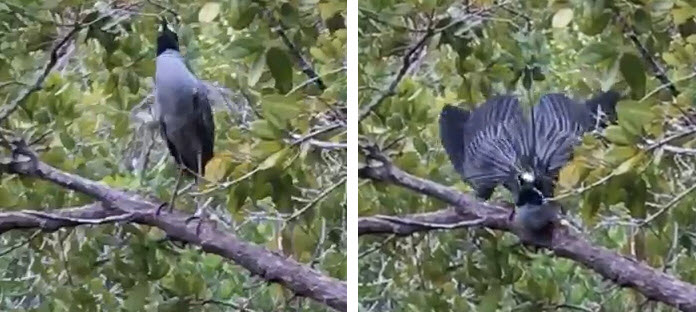Marsha C. Salett and Jaden Thompson

Yellow-crowned Night-Heron. Photographs by Jaden Thompson.
The J.N. "Ding" Darling National Wildlife Refuge on Sanibel Island, Florida, in February and March is a birder's antidote to late winter in New England. At low and mid-tides, the exposed flats are teeming with waders and shorebirds. Late afternoon on March 23, 2017, after a passing cloudburst, my grandson Jaden and I timed our visit just right. Birding the refuge's 4-mile Wildlife Drive, we saw White Pelicans, Roseate Spoonbills, several sandpipers including Black-necked Stilt (life bird for Jaden), and just about every species of egret and heron except for Yellow-crowned Night-Heron.
The last half-mile of the drive tends to be less birdy, but we like to stop at the two mangrove swamp overlooks to search for alligators in the shallows. At the first pool, we'd barely had time to scan for alligators when a small, bright yellow ball flew past us and landed on a branch just above water level. "Prothonotary Warbler!" Jaden and I called out simultaneously. It hopped about silently in full view—this had to be the bird of the day—and we were so enthralled at seeing the warbler low and close, that I don't know how long it took us to register the strange h-whoop sounds that were definitely not part of the Prothonotary's repertoire.
The h-whoops—repeated at short, regular intervals—were nearby and overhead. We looked up to find a Yellow-crowned Night-Heron in full breeding plumage displaying on a bare branch diagonally over the water and directly above us, not more than 3–4 feet away. It ignored us completely and repeated its display approximately every 20 seconds. We'd finally found the last heron we were looking for. We scanned the mangroves looking for a female but found no other night-herons.
Neither of us had ever seen a Yellow-crowned Night-Heron display. Usually, the night-herons we see are the occasional juvenile skulking in the phragmites at Wellfleet Bay Wildlife Sanctuary or birds flying high above as they leave the Eastham roost for the night.
This bird's display was magnificent with its fancy feathers, fanned-out wings, and striking yellow forehead brighter than its crown. Standing on the branch, the night-heron stretched its body fully upright but kept its beak horizontal. Then it leaned forward and in a swift, fluid motion lowered its breast—with its scapular plumes bursting up fanlike behind its head—until its breast grazed the bottom of the branch and was lower than its tail. At that point it flared its wings open and upward, transforming itself into a slaty gray fan with contrasting silvery plumes and a central yellow spot that glowed like a tiny sun. Then with a h-whoop, it reversed it movements and resumed its posture as a bird on a branch. The entire display took about three seconds. We were speechless with wonder. It reminded me somewhat of the display of a Bird of Paradise.
Later, when I accessed the refuge's website in search of its bird list, I found this fact about Yellow-crowned Night-Herons: "By building their nests over alligator habitats, their hatchlings are protected from other pesky predators like raccoons." <https://www.fws.gov/refuge/JN_Ding_Darling/Big_five.html> So from now on, we'll look down into the mangrove swamp waters for alligators and up into the mangrove trees for Yellow-crowned Night-Herons and their nests.